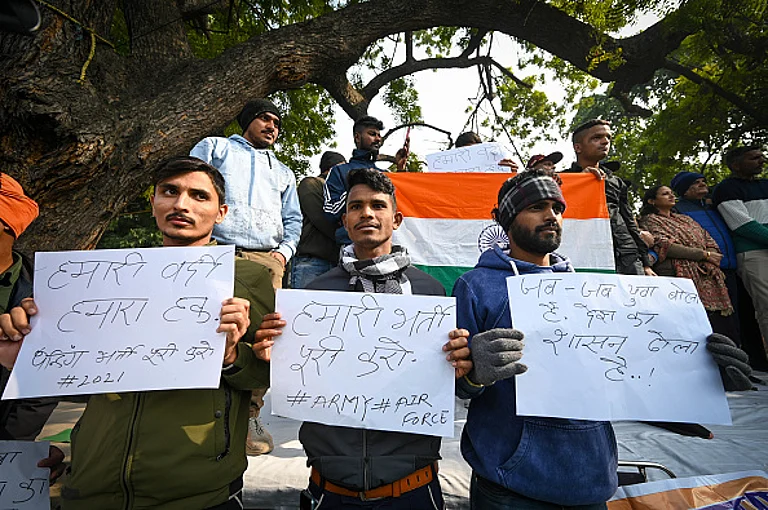Last week, Leader of Opposition Rahul Gandhi’s speech in Parliament about the Agnipath scheme triggered a row after he claimed that the family of Agniveer Ajay Kumar – who was killed in a landmine blast on the line of duty last year – had not received due compensation to date.
Agnipath Scheme Row: How Different Is The Compensation On Death For Agniveers Than For Regular Soldiers?
Since the launch of the Agnipath scheme, it has been drawn into many controversies
Gandhi cited Ajay's case in his Motion of Thanks after Defence Minister Rajnath Singh intervened in the senior Congress leader’s speech and asked him not to “mislead the Parliament” on the short-term military recruitment scheme which was brought after taking suggestions from 158 organisations. To this, Gandhi alleged that Singh "lied" in Parliament about the issue of compensation and criticised the Agnipath scheme not even giving them the status of a "shaheed" (martyr). He also released a video on social media purportedly of Ajay’s father saying they had not received the compensation.
However, a day after the war of words, the Indian Army released a statement rejecting the claims about non-payment of the compensation. "It is emphasised that the Indian Army salutes the supreme sacrifice made by Agniveer Ajay Kumar. The last rites were carried out with full military honours. Of the total amount due, family of Agniveer Ajay has already been paid Rs 98.39 lakhs," the Army said in the post. The total amount will be Rs 1.65 crore approximately, it noted.
The Agnipath scheme was announced on June 14, 2022, for more Indian youth to join the forces. It is a short-term recruitment program for youth between the age of 17 and half years and 23 for only four years, with a provision to retain 25 per cent of them for 15 more years. However, since its launch, it has been drawn into many controversies.
To understand the latest controversy better, Outlook breaks down how the compensation for Agniveers differs from that of regular soldiers:
Firstly, it is important to note that the compensation on death for Agniveers is divided into categories X, Y, Z, whereas for regular soldiers, it is based on categories A to E. Category A for regular soldiers and category X for Agniveers are for non-duty related deaths, Category B and C for regular soldiers and Y for Agniveers are for on-duty accidents, and Category D and E for regular soldiers and Z for Agniveers relate to deaths occurred during war, violence, natural calamities and enemy action.
Insurance
Soldiers hired through the regular entrance contribute Rs 5,000 per month from their salary towards the Army Group Insurance Fund , insuring them for Rs 50 lakh. Meanwhile, Agniveers get an insurance cover of Rs 48 lakh from the government. They do not make any contribution to this from their salary.
This sum is paid to all soldiers irrespective of the cause of death.
Ex gratia
Agniveers of Y and Z category get a one time ex-gratia of Rs 44 lakh, whose deaths have occurred on line of duty or are attributable to military service. Similarly, for a regular soldier, the ex gratia is Rs 25 lakh, Rs 35 lakh or Rs 45 lakh, depending on the nature of the casualty. In addition to this, state governments also provide ex gratia to these soldiers anywhere between zero to Rs 1 crore.
Agniveers in category X and regular soldiers in category A are not eligible to ex gratia.
Additionally, an amount of Rs 8 lakh is also given to both regular soldiers and Agniveers if the death occurred on line of duty, and Rs 2.5 lakh if they died due to some other cause.
Seva Nidhi Fund for Agniveers
The Seva Nidhi fund is a contributory scheme in which a corpus of Rs 5 lakh with added interest is matched by the GoI after four years of service (totalling to Rs 10 lakh) and paid to the exiting Agniveers.
In case of a death on line of duty or attributable to military service (Y and Z), Agniveers are paid in full for the unserved period upto four years (wef date of death) including Seva Nidhi component. In case of non-duty deaths, Agniveers are paid the balance accumulated till the date of death along with the accrued interest and GoI contribution.
Exclusive benefits for regular cadres
One of the major reasons the Agnipath scheme has been controversial is because it does not provide monthly family pension and gratuity to Agniveers who exit after four years of service or die while on service.
In case of death of a regular soldier in B, C, D or E category, a death gratuity equivalent to 15 days’ pay for every completed year of service (or part) is granted, with a maximum limit of Rs 25 lakh.
In terms of pension, soldiers who died on line of duty (B,C) are entitled to special family pension, that is 60% of last drawn salary by the deceased. Soldiers killed in operations attributable to military service (D, E) are entitled to liberalised family pension, that is equal to th last drawn salary.
Those who died not due to military duties (category A), get a regular family pension, that is 50 per cent of the last drawn salary for up to 10 years, and 30 per cent thereafter.
In addition to these, dependents of a soldier who died while in military service – such as parents, widow and children – are also entitled to benefits like monthly allowances and educational reservations. These benefits are not available for Agniveers.
